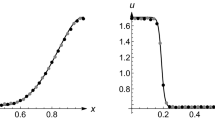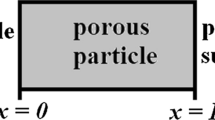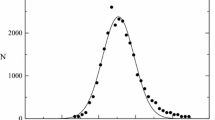Abstract
Approaching dynamical aspects in systems with localised sink term is fundamentally relevant from the physical-experimental point of view. However, theoretical advances have not progressed much in this direction; this is due to the great difficulty of addressing such types of problems from an analytic point of view. In this work, we investigate the systems sink points (like traps) considering a dynamics governed by the like reaction–diffusion equation in the presence of fractional derivatives. In order to do so, making use of the continuous-time random walks theory we constructed a model that contains multiples sink terms, on sequence we analysed the problem for two cases: first, considering only a single sink term and, second, considering multiples sink point associated with a fractal set. In both cases, we present the analytic solution in terms of Fox and Mittag–Leffler functions. Moreover, we perform a calculus of the mean square displacement and survival probability. The proposal and the techniques used in this work are useful to describe anomalous diffusive phenomena and the transport of particles in irregular media.





Similar content being viewed by others
References
K Falconer Fractal Geometry: Mathematical Foundations and Applications (New York: Wiley) (2004)
J Sabatier, O P Agrawal, and J T Machado Advances in Fractional Calculus, vol 4 (Berlin: Springer) (2007)
J A Kaandorp Fractal Modelling: Growth and Form in Biology (Berlin: Springer) (2012)
A Szabo, G Lamm and G H Weiss J. Stat. Phys. 34 1 (1984)
V Kuzovkov and E Kotomin Rep. Prog. Phys. 51(12) 1479 (1988)
F Family and D P Landau Kinetics of Aggregation and Gelation (Amsterdam: Elsevier) (2012)
E G Flekkoy Phys. Rev. E 95 012139 (2017)
A Einstein Ann. Phys. 322 549 (1905)
R Metzler and J Klafter Phys. Rep. 339 1 (2000)
S A McKinley and H D Nguyen SIAM J. Math. Anal. 50 5119 (2018)
R Morgado, F A Oliveira, G G Batrouni and A Hansen Phys. Rev. Lett. 89 100601 (2002)
L C Lapas, R Morgado, M H Vainstein, J M Rubí and F A Oliveira Phys. Rev. Lett .101 230602 (2008)
M H Vainstein, I V L Costa, R Morgado and F A Oliveira Phys. Rev. Lett. 73 726732 (2006)
F A Oliveira, R M S Ferreira, L C Lapas and M H Vainstein Front. Phys. 7 18 (2019)
M A F dos Santos Fractal Fract. 2 20 (2018)
Z Tomovski, T Sandev, R Metzler, and J Dubbeldam Phys. A Stat. Mech. Appl. 391 2527 (2012)
J Hristov Prog. Fract. Differ. Appl. 3 19 (2017)
D del Castillo-Negrete Phys. Plasmas 13 082308 (2006)
R Metzler, J -H Jeon, A G Cherstvy and E Barkai Phys. Chem. Chem. Phys. 16 24128 (2014)
M A F dos Santos J. Stat. Mech. 2019(3) 033214 (2019). https://doi.org/10.1088/1742-5468/ab081b
L F Richardson Proc. R. Soc. Lond. A 110 709 (1926)
H Scher and E W Montroll Phys. Rev. B 12 2455 (1975)
V E Tarasov Commun. Nonlinear Sci. Numer. Simul. 18 2945 (2013)
E Nadal, J V Aguado, E Abisset-Chavanne, F Chinesta, R Keunings and E Cueto Appl. Math. Model. 51 58 (2017)
M A F dos Santos and I S Gomez J. Stat. Mech. Theory Exp. 2018 123205 (2018)
A Bhrawy and M Zaky Appl. Numer. Math. 111 197 (2017)
A Ortega, J Rosales, L Martínez and C Carreñoc Optik 161 244 (2018)
J Gómez-Aguilar Optik 168 728 (2018)
B B Mandelbrot The Fractal Geometry of Nature (New York: WH freeman) (1982)
T S Vicsek Fractal Growth Phenomena (Singapore: World Scientific) (1992)
T Pajkossy and L Nyikos J. Electrochem. Soc. 133 2061 (1986)
V E Tarasov Chaos Interdiscip. J. Nonlinear Sci. 15 023102 (2005)
A K Golmankhaneh, A Fernandez, A K Golmankhaneh and D Baleanu Entropy 20 504 (2018)
I Podlubny Fractional Differential Equations: An Introduction to Fractional Derivatives, Fractional Differential Equations, to Methods of Their Solution and Some of Their Applications, vol 198 (Amsterdsam: Elsevier) (1998)
D Z Rudner, Q Pan, and R M Losick Proc. Natl. Acad. Sci. 99 8701 (2002)
U Habiba, A M Afifi, A Salleh and B C Ang J. Hazard. Mater. 322 182 (2017)
J M Dickhout, J Moreno, P Biesheuvel, L Boels, R G Lammertink and W M de Vos J. Colloid Interface Sci. 487 523 (2017)
P Tan, J Sun, Y Hu, Z Fang, Q Bi, Y Chen and J Cheng J. Hazard. Mater. 297 251 (2015)
Y Yurekli J. Hazard. Mater. 309 53 (2016)
P Tan, Y Liang, Q Xu, E Mamontov, J Li, X Xing and L Hong Phys. Rev. Lett. 120 248101 (2018)
L Wang, A Dumoulin, M Renner, A Triller and C G Specht PloS one 11 e0148310 (2016)
M Damak, S R Mahmoudi, M N Hyder and K K Kripa Nat. Commun. 7 12560 (2016)
H Röder, E Hahn, H Brune, J-P Bucher and K Kern Nature 366 6451 (1993)
H Brune, C Romainczyk, H Röder and K Kern Nature 369 6480 (1994)
B Ross Hist. Math. 4 75 (1977)
R Gorenflo and A Kilbas Mittag-Leffler Functions, Related Topics and Applications (Berlin: Springer) (2014)
J T Machado, V Kiryakova and F Mainardi Commun. Nonlinear Sci. Numer. Simul. 16 1140 (2011)
N Sene and A N Fall Fractal Fract. 3 14 (2019)
M A Herzallah J. Fract. Calc. Appl. 5 1 (2014)
J T Machado in Acoustics and Vibration of Mechanical Structures—AVMS-2017 (Berlin: Springer) p 3 (2018)
N Laskin Phys. Rev. E 66 056108 (2002)
B Henry, T Langlands and S Wearne Phys. Rev. E 74 031116 (2006)
M A F dos Santos, M K Lenzi and E K Lenzi Chin. J. Phys. 55 1294 (2017)
M A F dos Santos, M K Lenzi and E K Lenzi Adv. Math. Phys. 2017 6361598 (2017)
S B Yuste, L Acedo and K Lindenberg Phys. Rev. E 69 036126 (2004)
T Sandev, R Metzler and A Chechkin Fract. Calc. Appl. Anal. 21 10 (2018)
E K Lenzi, M A F dos Santos, D S Vieira, R S Zola and H V Ribeiro Phys. A Stat. Mech. Appl. 443 32 (2016)
S H Northrup and J T Hynes J. Chem. Phys. 73 2700 (1980)
G Wilemski and M Fixman J. Chem. Phys. 58(9) 4009 (1973)
S H Northrup and J T Hynes J. Chem. Phys. 71 871 (1979)
D F Calef and J M Deutch Annu. Rev. Phys. Chem. 34(1) 493 (1983)
K Seki, K Murayama and M Tachiya Phys. Rev. B 71 235212 (2005)
K Seki, M Wojcik and M Tachiya J. Chem. Phys. 124 044702 (2006)
Y-S Ho and G McKay Process Saf. Environ. Prot. 76 183 (1998)
T S Chandra, S Mudliar, S Vidyashankar, S Mukherji, R Sarada, K Krishnamurthi and V Chauhan Bioresour. Technol. 184 395 (2015)
J Yan, Y Huang, Y -E Miao, W W Tjiu and T Liu J. Hazard. Mater. 283 730 (2015)
S Homaeigohar and M Elbahri NPG Asia Mater. 9(8) e427 (2017)
J Sung, E Barkai, R J Silbey and S Lee J. Chem. Phys. 116 2338 (2002)
T Sandev, A Iomin and H Kantz Phys. Rev. E 95 052107 (2017)
T Sandev, A Schulz, H Kantz and A Iomin Chaos Solitons Fractals 114 551 (2018)
V E Tarasov Phys. Lett. A 336 167 (2005)
T Sandev, A Iomin and V Méndez J. Phys. A Math. Theor. 49 355001 (2016)
T R Prabhakar Yokohama Math. J. 19 7 (1971)
M A F dos Santos Physics2019 033214 (2019)
T Sandev Mathematics 5 66 (2017)
A Stanislavsky and A Weron J. Chem. Phys. 149 044107 (2018)
A M Mathai, R K Saxena and H J Haubold The H-function: Theory and Applications (Berlin: Springer) (2009)
Acknowledgements
M. A. F. dos Santos acknowledges the support of the Brazilian agency CNPq.
Author information
Authors and Affiliations
Corresponding author
Additional information
Publisher's Note
Springer Nature remains neutral with regard to jurisdictional claims in published maps and institutional affiliations.
Appendix A
Appendix A
The Fox H function (or \({\text{ H }}\)-function) may be defined in terms of the Mellin–Barnes-type integral [77]
with
where m, n, p and q are integers satisfying \(0\le n\le p\) and \(1\le m\le q\). It may also be defined by its Mellin transform
Here, the parameters have to be defined such that \(A_{j}>0\) and \(B_{j}>0\) and \(a_j(b_{h}+\nu )\ne B_{h}(a_{j}-\lambda -1)\) where \(\nu ,\lambda =0,1,2, \ldots ,\)\(h=1,2, \ldots ,m\) and \(j=1,2, \ldots ,m\). The contour L separates the poles of \(\Gamma \left( b_{j}-B_{j}\xi \right)\) for \(j=1,2, \ldots ,m\) from those of \(\Gamma \left( 1-a_{j}+A_{j}\xi \right)\) for \(j=1,2, \ldots ,n\). The \({\text{ H }}\)-function is analytic in x if either (i) \(x\ne 0\) and \(M>0\) or (ii) \(0<|x|<1/B\) and \(M=0\), where \(M=\sum _{j=1}^{q}B_{j}-\sum _{j=1}^{p}A_{j}\) and \(B=\prod _{j=1}^{p}A_{j}^{A_{j}}\prod _{j=1}^{q}B_{j}^{-B_{j}}\).
Some useful properties of the Fox H-function found in Refs. [77] are listed below.
(i) The H-function is symmetric in the pairs \((a_{1},A_{1}),\ldots , (a_{p},A_{p})\), likewise \((a_{n+1},A_{n+1}),\ldots ,(a_{p}, A_{p})\); in \((b_{1}, B_{1}), \ldots , (b_{q}, B_{q})\) and in \((b_{n+1}, B_{n+1}), \ldots , (b_{q}, B_{q})\).
(ii) For \(k>0\)
(iii) The multiplication rule is
(iv) For \(n\ge 1\) and \(q>m\),
(v) For \(m\ge 2\) and \(p>n\)
(vi) The relation between the generalised Mittag–Leffler function and the Fox H function is given by
(vii) Under Fourier cosine transformation, the H function transforms as
(viii) If the poles of \(\prod _{j=1}^{m}\Gamma \left( b_{j}-B_{j}\xi \right)\) are simple, the following series expansion is valid:
Rights and permissions
About this article
Cite this article
dos Santos, M.A.F. A fractional diffusion equation with sink term. Indian J Phys 94, 1123–1133 (2020). https://doi.org/10.1007/s12648-019-01543-2
Received:
Accepted:
Published:
Issue Date:
DOI: https://doi.org/10.1007/s12648-019-01543-2




